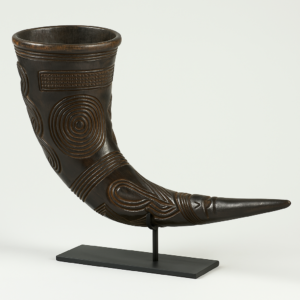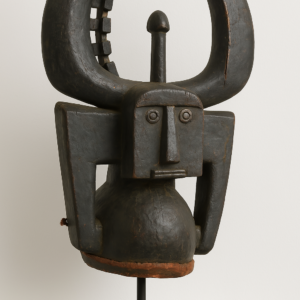“The Crowned Spirit Head,” translated into Yoruba as “Ori Irunmole,” is an exceptional bronze commemorative sculpture drawn from the sacred aesthetic canon of the ancient Yoruba civilization of Ife, Nigeria. This piece, embodying elevated craftsmanship, spiritual symbolism, and courtly prestige, is a rare fusion of religious abstraction and regal portraiture that has come to define Yoruba classical art.
This striking bronze head is a celebration of the metaphysical concept of “Ori” in Yoruba cosmology. Ori—which literally means “head”—is far more than the physical cranium; it is believed to be the essence of a person’s soul, destiny, and inner spirit. In Yoruba culture, honoring the head is honoring the divine within. This sculpture reflects not just a human figure, but a divine persona, possibly a royal ancestor or deity figure, whose essence is immortalized in bronze.
What distinguishes Ori Irunmole is the majestic conical crown—a towering structure textured in intricate, crosshatched patterns. This headdress is a visual code for royalty, sacred leadership, and ancestral lineage. It mimics the ornate beaded veils worn by Yoruba Obas (kings) during ceremonial rituals, suggesting that the subject may be a ruler or a priestly entity with deep spiritual authority. In Yoruba belief, only those who commune directly with the orisha (divine spirits) are worthy of such an adornment.
The face beneath this crown exudes serenity and controlled power. The features are beautifully idealized—the high cheekbones, almond-shaped eyes, full lips, and delicately flared nostrils are symmetrical and poised. The stylization leans toward naturalism while maintaining a sense of perfection that reflects divine character rather than earthly likeness. The downward cast of the eyes reinforces the idea of inner awareness, spiritual contemplation, and the dignity of silence.
The surface patina of the bronze is a rich blend of warm gold and burnished brown, achieved through centuries of oxidation and the use of traditional lost-wax casting. This process—practiced for over a millennium by Yoruba bronze guilds—gives the sculpture a timeless aura, as though it were both ancient and eternal. Fine vertical striations around the neck, similar to ceremonial bead collars, indicate not just decorative elegance, but symbolic protection and ancestral prestige.
Placed in a palace setting or shrine, pieces like Ori Irunmole were not ornamental—they were part of elaborate ritual systems of memory, power, and continuity. They stood on altars dedicated to kings or sacred figures, where libations, songs, and prayers were offered to preserve the presence of the honored spirit. These heads served as anchors for ancestral blessings, and were integral to the Yoruba belief in ase—the life force or divine energy that flows through all things.
What makes this piece extraordinary is its multi-dimensional function. It is simultaneously an object of veneration, an artistic triumph, a political tool, and a cultural archive. It encapsulates the Yoruba worldview that art is not separate from life, but is life itself—coded in bronze, poetry, and sacred rhythm.
In modern contexts, Ori Irunmole becomes more than a historical artifact. It becomes a symbol of Afrocentric excellence, spiritual royalty, and intellectual legacy. Whether displayed in a gallery, museum, or private collection, it becomes a visual compass pointing back to a time when Africa produced works of such refined detail and philosophical depth that they rivaled any in the ancient world.
For collectors and designers, this piece brings gravitas to a space—rooting it in ancestral elegance and spiritual memory. For curators and educators, it offers a powerful narrative about the ingenuity of pre-colonial African societies and the sacred language of form, line, and material. And for descendants of the Yoruba tradition, it is a mirror of heritage, pride, and presence.
Ultimately, Ori Irunmole is a call to remember the sacredness of self, the nobility of origin, and the enduring power of cultural memory.





Reviews
There are no reviews yet.